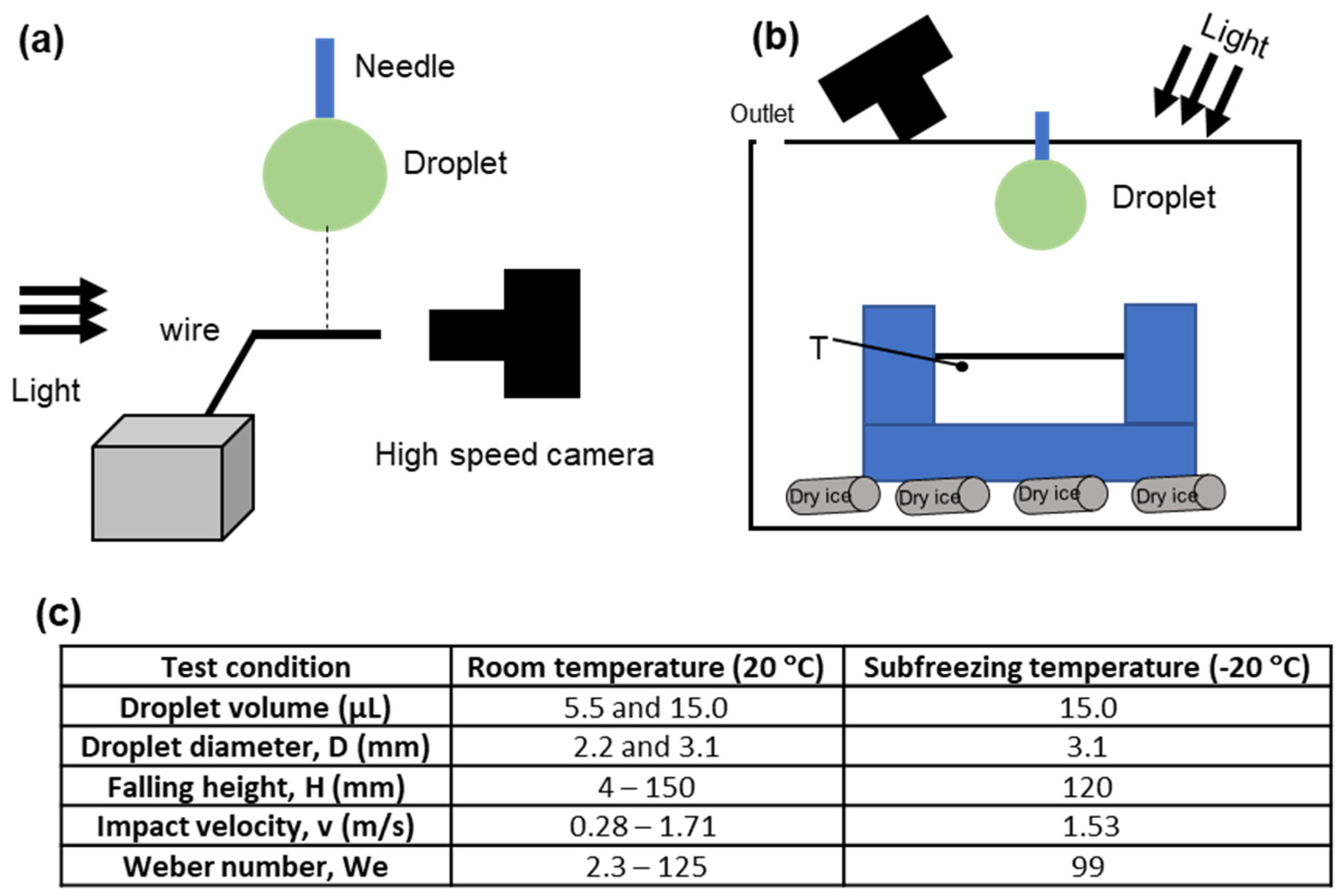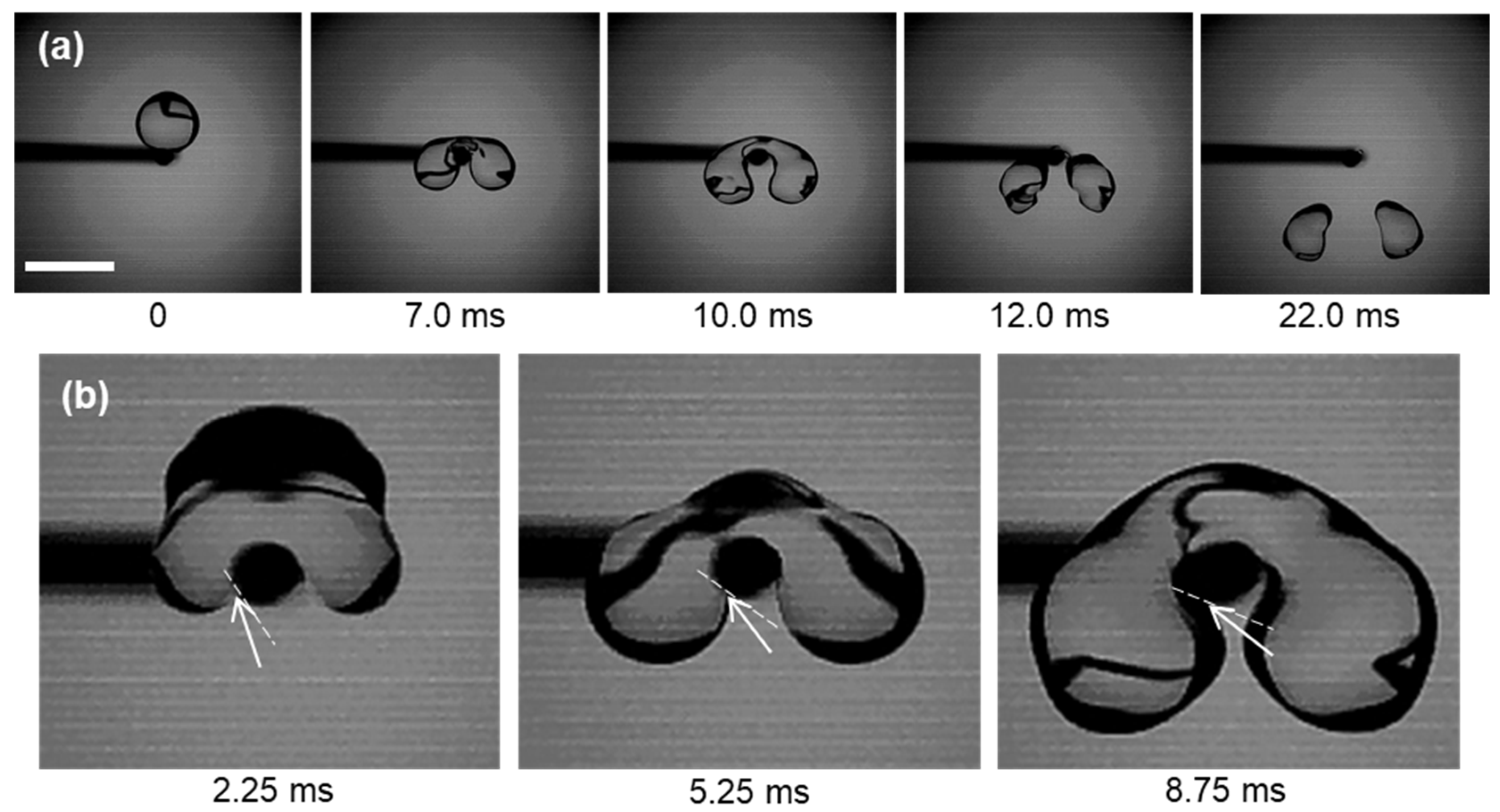Splitting an Impacting Droplet by a Superhydrophobic Wire
Abstract
:1. Introduction
2. Experimental Section
2.1. Hydrophobization of Stainless-Steel Wire
2.2. Experimental Setup for Tests at Room Temperature
2.3. Experimental Setup for Tests at Subfreezing Temperature
3. Results & Discussion
3.1. Effect of the Wire Wettability on Droplet Splitting Behaviors
3.2. Threshold for the Droplet Splitting
3.3. Anti-Icing of the Superhydrophobic Wire
4. Conclusions
Supplementary Materials
Author Contributions
Funding
Institutional Review Board Statement
Informed Consent Statement
Data Availability Statement
Conflicts of Interest
References
- Ding, Y.; Howes, P.D.; deMello, A.J. Recent advances in droplet microfluidics. Anal. Chem. 2019, 92, 132–149. [Google Scholar] [CrossRef] [PubMed]
- Jiang, M.; Wang, Y.; Liu, F.; Du, H.; Li, Y.; Zhang, H.; To, S.; Wang, S.; Pan, C.; Yu, J.; et al. Inhibiting the Leidenfrost effect above 1000 °C for sustained thermal cooling. Nature 2022, 601, 568–572. [Google Scholar] [CrossRef]
- Song, D.; Bhushan, B. Bioinspired triangular patterns for water collection from fog. Philos. Trans. R. Soc. A Math. Phys. Eng. Sci. 2019, 377, 20190128. [Google Scholar] [CrossRef] [PubMed] [Green Version]
- Song, D.; Bhushan, B. Optimization of bioinspired triangular patterns for water condensation and transport. Philos. Trans. R. Soc. A Math. Phys. Eng. Sci. 2019, 377, 20190127. [Google Scholar] [CrossRef] [Green Version]
- Lohse, D. Fundamental fluid dynamics challenges in inkjet printing. Annu. Rev. Fluid Mech. 2022, 54, 349–382. [Google Scholar] [CrossRef]
- Chen, L.; Li, D.; Liu, X.; Xie, Y.; Shan, J.; Huang, H.; Yu, X.; Chen, Y.; Zheng, W.; Li, Z. Point-of-Care Blood Coagulation Assay Based on Dynamic Monitoring of Blood Viscosity Using Droplet Microfluidics. ACS Sens. 2022, 7, 2170–2177. [Google Scholar] [CrossRef]
- Xu, J.; Xiu, S.; Lian, Z.; Yu, H.; Cao, J. Bioinspired materials for droplet manipulation: Principles, methods and applications. Droplet 2022, 1, 11–37. [Google Scholar] [CrossRef]
- Song, D.; Bhushan, B. Enhancement of water collection and transport in bioinspired triangular patterns from combined fog and condensation. J. Colloid Interface Sci. 2019, 557, 528–536. [Google Scholar] [CrossRef]
- Nelson, W.C.; Kim, C.-J. Droplet Actuation by Electrowetting-on-Dielectric (EWOD): A Review. J. Adhes. Sci. Technol. 2012, 26, 1747–1771. [Google Scholar] [CrossRef] [Green Version]
- Lee, Y.; Amberg, G.; Shiomi, J. Vibration sorting of small droplets on hydrophilic surface by asymmetric contact-line friction. PNAS Nexus 2022, 1, pgac027. [Google Scholar] [CrossRef]
- Guo, Y.; Song, D.; Song, B.; Hu, H. Manipulating dynamic drops using a hybrid superhydrophobic/hydrophilic surface. Appl. Surf. Sci. 2016, 387, 1225–1229. [Google Scholar] [CrossRef]
- Sam, E.K.; Sam, D.K.; Lv, X.; Liu, B.; Xiao, X.; Gong, S.; Yu, W.; Chen, J.; Liu, J. Recent development in the fabrication of self-healing superhydrophobic surfaces. Chem. Eng. J. 2019, 373, 531–546. [Google Scholar] [CrossRef]
- Latthe, S.S.; Sutar, R.S.; Kodag, V.S.; Bhosale, A.; Kumar, A.M.; Sadasivuni, K.K.; Xing, R.; Liu, S. Self–cleaning superhydrophobic coatings: Potential industrial applications. Prog. Org. Coat. 2019, 128, 52–58. [Google Scholar] [CrossRef]
- Dalawai, S.P.; Aly, M.A.S.; Latthe, S.S.; Xing, R.; Sutar, R.S.; Nagappan, S.; Ha, C.-S.; Sadasivuni, K.K.; Liu, S. Recent advances in durability of superhydrophobic self-cleaning technology: A critical review. Prog. Org. Coat. 2020, 138, 105381. [Google Scholar] [CrossRef]
- Sarshar, M.A.; Swarctz, C.; Hunter, S.; Simpson, J.; Choi, C.-H. Effects of contact angle hysteresis on ice adhesion and growth on superhydrophobic surfaces under dynamic flow conditions. Colloid Polym. Sci. 2013, 291, 427–435. [Google Scholar] [CrossRef]
- Liu, Y.; Song, D.; Choi, C.-H. Anti- and de-icing behaviors of superhydrophobic fabrics. Coatings 2018, 8, 198. [Google Scholar] [CrossRef] [Green Version]
- Sarshar, M.A.; Song, D.; Swarctz, C.; Lee, J.; Choi, C.-H. Anti-icing or deicing: Icephobicities of superhydrophobic surfaces with hierarchical structures. Langmuir 2018, 34, 13821–13827. [Google Scholar] [CrossRef] [PubMed]
- Bird, J.C.; Dhiman, R.; Kwon, H.M.; Varanasi, K.K. Reducing the contact time of a bouncing drop. Nature 2013, 503, 385–388. [Google Scholar] [CrossRef]
- Haikun, Z.; Shinan, C.; Yuanyuan, Z. Anti-icing & icephobic mechanism and applications of superhydrophobic/ultra slippery surface. Prog. Chem. 2017, 29, 102. [Google Scholar] [CrossRef]
- Kulinich, S.A.; Farzaneh, M. Ice adhesion on super-hydrophobic surfaces. Appl. Surf. Sci. 2009, 255, 8153–8157. [Google Scholar] [CrossRef]
- Song, D.; Jiang, Y.; Sarshar, M.A.; Choi, C.-H. Icephobicities of Superhydrophobic Surfaces. In Ice Adhesion; John Wiley & Sons: Hoboken, NJ, USA, 2020; pp. 361–388. [Google Scholar] [CrossRef]
- Song, D.; Jiang, Y.; Chou, T.; Asawa, K.; Choi, C.-H. Spontaneous Deicing on Cold Surfaces. Langmuir 2020, 36, 11245–11254. [Google Scholar] [CrossRef] [PubMed]
- Anand, S.; Paxson, A.T.; Dhiman, R.; Smith, J.D.; Varanasi, K.K. Enhanced condensation on lubricant-impregnated nanotextured surfaces. ACS Nano 2012, 6, 10122–10129. [Google Scholar] [CrossRef] [PubMed]
- Li, H.; Bai, R.; Zhao, Z.; Tao, L.; Ma, M.; Ji, Z.; Jian, M.; Ding, Z.; Dai, X.; Bao, F.; et al. Application of droplet digital PCR to detect the pathogens of infectious diseases. Biosci. Rep. 2018, 38, BSR20181170. [Google Scholar] [CrossRef] [Green Version]
- Tofan, T.; Jasevičius, R. Modelling of the Motion and Interaction of a Droplet of an Inkjet Printing Process with Physically Treated Polymers Substrates. Appl. Sci. 2021, 11, 11465. [Google Scholar] [CrossRef]
- Huang, C.; Fang, W.; Ke, M.; Chou, H.; Yang, J.T. A biocompatible open-surface droplet manipulation platform for detection of multi-nucleotide polymorphism. Lab Chip 2014, 14, 2057–2062. [Google Scholar] [CrossRef]
- Miljkovic, N.; Enright, R.; Wang, E.N. Effect of droplet morphology on growth dynamics and heat transfer during condensation on superhydrophobic nanostructured surfaces. ACS Nano 2012, 6, 1776–1785. [Google Scholar] [CrossRef]
- Neinhuis, C.; Barthlott, W. Characterization and distribution of water-repellent, self-cleaning plant surfaces. Ann. Bot. 1997, 79, 667–677. [Google Scholar] [CrossRef] [Green Version]
- Song, D.; Song, B.; Hu, H.; Du, X.; Du, P.; Choi, C.-H.; Rothstein, J.P. Effect of a surface tension gradient on the slip flow along a superhydrophobic air-water interface. Phys. Rev. Fluids 2018, 3, 033303. [Google Scholar] [CrossRef]
- Yanashima, R.; Garcia, A.A.; Aldridge, J.; Weiss, N.; Hayes, M.A.; Andrews, J.H. Cutting a Drop of Water Pinned by Wire Loops Using a Superhydrophobic Surface and Knife. PLoS ONE 2012, 7, e45893. [Google Scholar] [CrossRef]
- Bormashenko, E.; Bormashenko, Y. Non-Stick Droplet Surgery with a Superhydrophobic Scalpel. Langmuir 2011, 27, 3266–3270. [Google Scholar] [CrossRef]
- Mertaniemi, H.; Jokinen, V.; Sainiemi, L.; Franssila, S.; Marmur, A.; Ikkala, O.; Ras, R.H.A. Superhydrophobic Tracks for Low-Friction, Guided Transport of Water Droplets. Adv. Mater. 2011, 23, 2911–2914. [Google Scholar] [CrossRef] [PubMed]
- Richard, D.; Clanet, C.; Quéré, D. Contact time of a bouncing drop. Nature 2002, 417, 811. [Google Scholar] [CrossRef] [PubMed]
- Song, D.; Song, B.; Hu, H.; Du, X.; Zhou, F. Selectively splitting a droplet using superhydrophobic stripes on hydrophilic surfaces. Phys. Chem. Chem. Phys. 2015, 17, 13800–13803. [Google Scholar] [CrossRef]
- Song, D.; Bhushan, B. Water condensation and transport on bioinspired triangular patterns with heterogeneous wettability at a low temperature. Philos. Trans. R. Soc. A 2018, 377, 20180335. [Google Scholar] [CrossRef] [PubMed]







Publisher’s Note: MDPI stays neutral with regard to jurisdictional claims in published maps and institutional affiliations. |
© 2022 by the authors. Licensee MDPI, Basel, Switzerland. This article is an open access article distributed under the terms and conditions of the Creative Commons Attribution (CC BY) license (https://creativecommons.org/licenses/by/4.0/).
Share and Cite
Song, D.; Xu, C.; Song, B.; Pan, G.; Hu, H.; Choi, C.-H. Splitting an Impacting Droplet by a Superhydrophobic Wire. Coatings 2022, 12, 1866. https://doi.org/10.3390/coatings12121866
Song D, Xu C, Song B, Pan G, Hu H, Choi C-H. Splitting an Impacting Droplet by a Superhydrophobic Wire. Coatings. 2022; 12(12):1866. https://doi.org/10.3390/coatings12121866
Chicago/Turabian StyleSong, Dong, Changsheng Xu, Baowei Song, Guang Pan, Haibao Hu, and Chang-Hwan Choi. 2022. "Splitting an Impacting Droplet by a Superhydrophobic Wire" Coatings 12, no. 12: 1866. https://doi.org/10.3390/coatings12121866
APA StyleSong, D., Xu, C., Song, B., Pan, G., Hu, H., & Choi, C.-H. (2022). Splitting an Impacting Droplet by a Superhydrophobic Wire. Coatings, 12(12), 1866. https://doi.org/10.3390/coatings12121866








